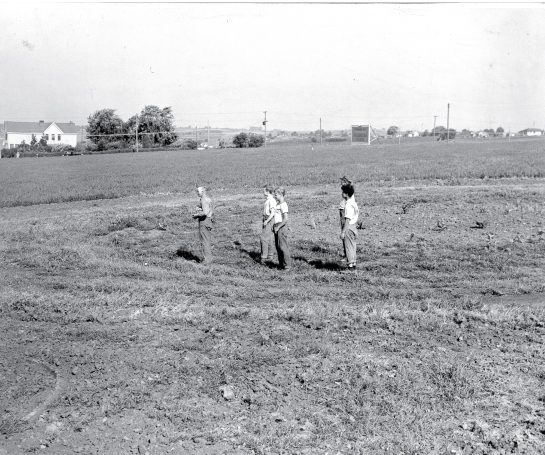Thoughts from the Archives – Settling Inspiration Hill

Seventy-six years ago in 1941, our Home needed a new campus. Sixty hilly acres at 52nd and Ames Streets were purchased and a local architect was told, “Give us your thoughts for a new campus, a new plan.”
As a result of this simple conversation, an elaborate plan was drawn up that was built around a curving boulevard featuring a traffic circle, something of a novelty in 1941. The plan still hangs in the Kevin Orr Historical Center on today’s Inspiration Hill campus. The man who led the movement to carve a campus out of farmland was Felix Carpenter, who lived in the Carriage House, our oldest building, with his wife during the construction years.
On weekends a few of the oldest and most reliable boys from the Megeath House came out to work with “Carp” as Felix Carpenter was known. There were plantings to make, fruit to pick in season, and brush to clean. The boys stayed in the Carriage House with Carp and his wife.
In July 1944 (photographers dated their work in those days) publicity pictures were taken to show the development progress being made. Carp took his four charges to the traffic circle then being formed and they posed for a picture which is shown here for you today.
The participants on this July 1944 day were: Felix Carpenter on the left (farm manager from 1942 to 1956), and the four boys clockwise from the upper left – Robert Williams (a resident from 1942 to 1946), Hal Fisk (1940 to 1944), Leo Segard (1939 to 1946), and Eddie McClain (1937 to 1946).
Look closely and you’ll see 52nd Street, then a two lane brick road in the country, in the background. A billboard, that we can see is yellow in color from an old home movie, proclaims the site to be the future home of the Omaha Masonic Home for Boys.
Much can happen in eight years. By 1952 the Home was fairly well settled in its new location. The four boys pictured here had moved on to the next phase of their lives, and Carp and his wife had turned their attention to a newer campus yet, one that would eventually be known as the Cooper Memorial Farm.
Also in 1952, a new farm manager’s cottage for Carp and his wife was built, and we changed our formal name to the Omaha Home for Boys. To signal the changing of the Home’s name, four heavy metal signs were built and painted white with red lettering. One was for 52nd Street, one for Ames Avenue, and two were held in reserve.
Today, Carp is but a memory, and we’ve lost touch with the four boys shown here. As for the signs, the two that stood along 52nd and Ames Streets have long since disappeared and now serve as interesting conversation pieces – either as patio or backyard decorations – at North Omaha homes. But the other 1952 signs in reserve, never used and still in pristine condition, stand guard in the basement of the Carriage House.
John E. Carter
